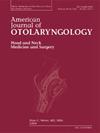Determinants of inpatient treatment in children with orbital cellulitis
IF 1.7
4区 医学
Q2 OTORHINOLARYNGOLOGY
引用次数: 0
Abstract
Background
Orbital cellulitis in children can lead to serious complications and necessitate hospitalization for management.
Objective
This study investigated predictors of inpatient hospitalization among pediatric patients receiving medical treatment for orbital cellulitis.
Methods
A retrospective cohort study of children treated for orbital cellulitis at West Virginia University Children's Hospital from January 2012–July 2022 was conducted. Patient characteristics, treatment setting (inpatient vs outpatient), orbital cellulitis type (preseptal vs postseptal), etiology of the orbital cellulitis (acute rhinosinusitis vs other), and presence of subperiosteal abscess were reviewed.
Results
The sample consisted of 100 pediatric patients with mean age of 7.0 years old (SD = 4.9). Inpatient treatment was required for 70 patients with a mean length of stay of 3.0 (SD = 1.7) days. In univariate regressions, acute rhinosinusitis (ARS), postseptal cellulitis, and subperiosteal abscess predicted necessitating inpatient treatment (p < 0.05 for all). In multivariate regressions, only ARS predicted treatment setting (p = 0.016) and no variables predicted length of stay (p > 0.05 for all).
Conclusion
In children who were treated medically for orbital cellulitis, ARS as the etiology was the main predictor necessitating inpatient treatment.
Level of evidence
4
眼眶蜂窝织炎患儿住院治疗的决定因素
背景:儿童眶蜂窝织炎可导致严重的并发症,需要住院治疗。目的探讨眼窝蜂窝织炎患儿住院的预测因素。方法对2012年1月至2022年7月在西弗吉尼亚大学儿童医院接受眼眶蜂窝织炎治疗的儿童进行回顾性队列研究。我们回顾了患者特征、治疗环境(住院与门诊)、眼眶蜂窝织炎类型(隔膜前与隔膜后)、眼眶蜂窝织炎的病因(急性鼻窦炎与其他)以及骨膜下脓肿的存在。结果100例儿童患者,平均年龄7.0岁(SD = 4.9)。70例患者需要住院治疗,平均住院时间为3.0 (SD = 1.7)天。在单变量回归中,急性鼻窦炎(ARS)、隔后蜂窝织炎和骨膜下脓肿预测需要住院治疗(p <;0.05)。在多变量回归中,只有ARS预测治疗环境(p = 0.016),没有变量预测住院时间(p >;0.05)。结论眼窝蜂窝织炎患儿接受内科治疗时,ARS为主要病因,是需要住院治疗的主要预测因素。证据水平4
本文章由计算机程序翻译,如有差异,请以英文原文为准。
求助全文
约1分钟内获得全文
求助全文
来源期刊

American Journal of Otolaryngology
医学-耳鼻喉科学
CiteScore
4.40
自引率
4.00%
发文量
378
审稿时长
41 days
期刊介绍:
Be fully informed about developments in otology, neurotology, audiology, rhinology, allergy, laryngology, speech science, bronchoesophagology, facial plastic surgery, and head and neck surgery. Featured sections include original contributions, grand rounds, current reviews, case reports and socioeconomics.
 求助内容:
求助内容: 应助结果提醒方式:
应助结果提醒方式:


